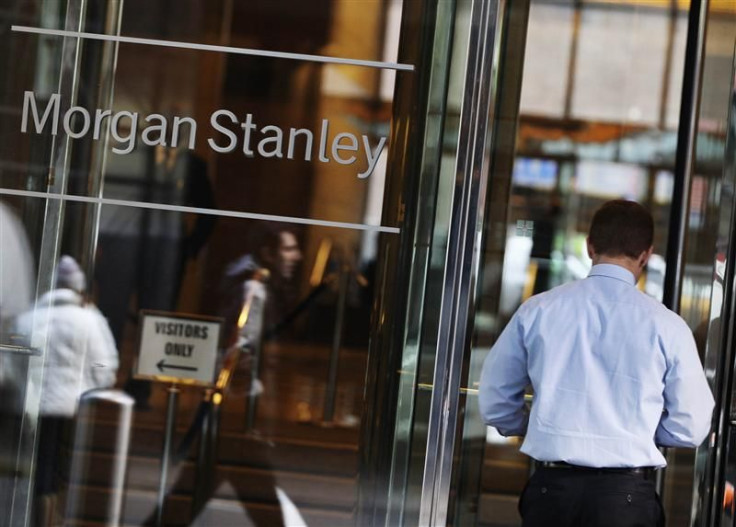Morgan Stanley Beats Expectations With Cost Cuts

(REUTERS) -- A pricey settlement over bond insurance pushed Morgan Stanley into the red in the fourth quarter, but the Wall Street bank still posted better-than-expected results, due to a focus on cost cuts and relatively strong performance in equities trading.
Morgan Stanley has been trying to cut back on everything, from BlackBerry bills to capital-hungry trading operations, reducing noncompensation expenses 7 percent. But the bank has struggled to trim compensation, its single largest expense.
The bank set aside $16.4 billion, or 51 percent of net revenue, for compensation. Its Morgan Stanley Smith Barney brokers took in more than trading and banking employees combined.
The wealth management payout ratio was 62 percent of revenue, while that for the trading and investment banking areas was 42 percent, excluding the legal settlement cost.
In contrast, Goldman Sachs Group Inc had a compensation-to-revenue ratio of 42 percent and JPMorgan Chase & Co's investment bank had a 34 percent ratio. Neither has significant brokerage operations.
Compensation costs added up at Morgan Stanley in part because of deferred obligations that came due in 2011 and higher productivity of financial advisers, which makes them eligible for bigger paychecks.
We're hitting costs very vigorously wherever we can -- wherever it makes sense without impeding the investment decisions we're making, so we still have growth for the future, Chief Financial Officer Ruth Porat said in an interview.
Although revenue was weak and pay was high, analysts said investors were impressed by the progress Morgan Stanley has made in turning around its trading operation and reducing other expenses. Morgan Stanley shares were up 5.1 percent to $18.23 in early afternoon trading on the New York Stock Exchange.
On the whole, management is making progress cleaning up legacy issues and growing tangible book, said Nomura analyst Glenn Schorr.
But Morgan Stanley's weak return-on-equity figure shows that the company is still a work in progress, Schorr said.
In 2011, Morgan Stanley's ROE was 3.9 percent, compared with levels as high as 40 percent before the crisis. ROE is a key sign of profitability for shareholders.
One way to boost that figure is cutting costs, but Morgan Stanley has been wary of reducing expenses to the point where it starts cutting into bone. It was the last among major banks to dive into the layoffs-bloodbath on Wall Street last year, in which tens of thousands of workers were dismissed to protect the bottom line.
Things are not looking better at rivals.
Banks including JPMorgan, Goldman and Citigroup have also reported steep declines in revenue for the fourth quarter from businesses such as sales and trading and investment banking, as the European debt crisis roiled capital markets and rattled clients, who dialed back on risk.
COST CUTS
Morgan Stanley said overall revenue in the quarter dropped 26 percent, to $5.7 billion, the weakest figure since the second quarter of 2009. But analysts were impressed with the bank's ability to gain market share from peers in equity trading, despite weak market conditions.
Morgan Stanley lost $275 million, or 15 cents per share, during the period, compared with earnings of $600 million, or 41 cents per share, a year earlier.
The results included a loss of $1.7 billion, or 59 cents per share, related to a settlement with MBIA Inc , announced previously.
The loss from continuing operations came to 14 cents a share, far better than the loss of 57 cents a share that Wall Street analysts had expected, on average, according to Thomson Reuters I/B/E/S.
Morgan Stanley tried to cut costs aggressively in some areas last year while making investments in others to build market share, Porat said in the interview with Reuters.
Porat said cost cuts helped bring down non-compensation expenses in the fourth quarter, even though it is a seasonally high quarter for those kind of expenses.
Targeted areas included trading businesses that will require more capital under new Basel 3 regulations. Areas of market-share growth for Morgan Stanley included equity derivatives, rates trading and foreign exchange trading, Porat said.
Morgan Stanley is maintaining its long-term target of cutting $1.4 billion in costs per year from the Morgan Stanley Smith Barney wealth management joint venture it shares with Citigroup Inc . The bank expects to reach $500 million in savings per year by the end of 2012.
In a conference call with analysts, CEO James Gorman said the bank would rather buy the 14 percent stake in Morgan Stanley Smith Barney from Citigroup than spend on share buybacks. But making that purchase depends on the price.
(Reporting By Lauren Tara LaCapra; Editing by Alwyn Scott, John Wallace and Tim Dobbyn)
© Copyright Thomson Reuters 2024. All rights reserved.




















